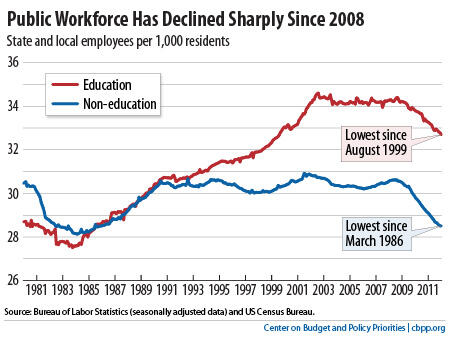BEYOND THE NUMBERS
Today’s encouraging jobs report would have been even more encouraging if local governments weren’t still slowing the economic recovery.
Local governments — mostly school districts — cut another 11,000 jobs last month. Total job losses at the state and local government levels have reached 668,000 since employment in this category peaked in August of 2008.

To put these figures in historical context, it’s useful to separate education workers (teachers, librarians, administrators, and so on in public schools, colleges, and universities) from other state and local workers (police, firefighters, garbage collectors, bus drivers, and so on). The education side of state and local employment has employed more people than the non-education side since the early 1990s, in part because of state education reforms that increased teacher hiring.
However, the public education workforce has shrunk over the last three years to its lowest level, relative to the U.S. population, since the late 1990s (see chart). The non-education state and local public workforce has shrunk to its lowest level since the mid-1980s.
Unfortunately, the downward trend in overall state and local employment shows no signs of slowing, due to continuing and upcoming budget cuts at the local, state, and federal levels. (About one-sixth of the federal budget goes to grants for state and local governments.)
A shrinking public-sector workforce as a share of the overall population can have a real impact on residents’ quality of life, since the services that states and localities provide — education, public safety, health care, and the like — tend to be pretty labor-intensive. It also risks undermining future economic growth, since businesses need educated, healthy workforces and safe streets to prosper.
